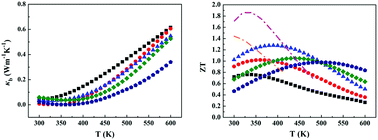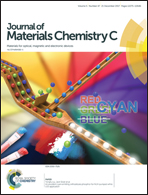Suppressed intrinsic excitation and enhanced thermoelectric performance in AgxBi0.5Sb1.5−xTe3
Abstract
Bi2Te3-based alloys are the most well-known thermoelectric materials for room-temperature applications. However, the maximum ZT values of Bi2Te3-based materials are usually achieved near room temperature. The ZT values dramatically drop above 400 K because of the intrinsic thermal excitation in Bi2Te3-based materials, which seriously restricts their applications as thermoelectric power generators. In this study, by doping a tiny amount of Ag into Bi0.5Sb1.5Te3, we successfully suppressed the intrinsic excitation in p-type Bi2Te3-based materials and shifted the ZT peak temperature to high temperatures. Eventually, due to the enhanced power factor and greatly depressed bipolar thermal conductivity at high temperature, a maximum ZT of 1.25 at 400 K was obtained in Ag0.002Bi0.5Sb1.498Te3, and an average ZT value of approximately 1.03 was achieved between 300 and 600 K. The theoretical energy conversion efficiency of the TE module fabricated with Ag0.002Bi0.5Sb1.498Te3 achieves a maximum value of 11.0% when ΔT = 300 K, which makes p-type Bi2Te3-based devices attractive for applications in TE power generation.



 Please wait while we load your content...
Please wait while we load your content...